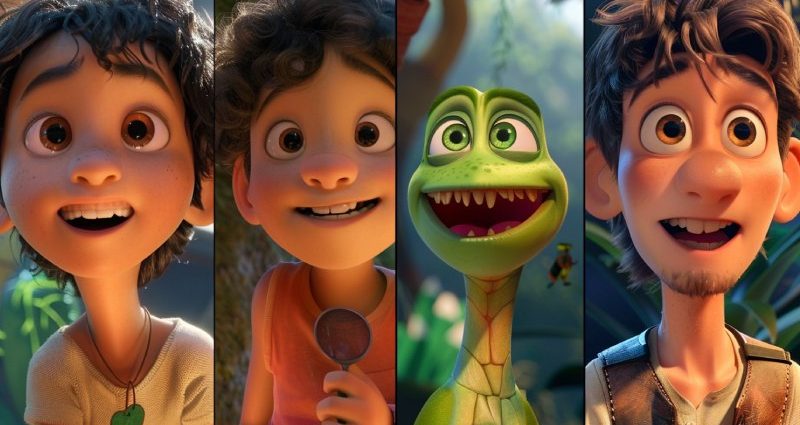Animation has come a long way since its inception, evolving from hand-drawn images to sophisticated digital creations. This journey reflects advancements in technology, artistry, and storytelling, reshaping how we create and experience animated content. Let’s explore the fascinating evolution of animation, from traditional techniques to the digital age.
The Beginnings of Animation: Traditional Techniques
Early Experiments and Pioneers
Animation’s roots can be traced back to early experiments with motion and visual storytelling. In the late 19th and early 20th centuries, pioneers like Émile Reynaud and Winsor McCay brought still images to life through devices like the praxinoscope and hand-drawn animations. McCay’s “Gertie the Dinosaur” (1914) is a landmark in animation history, showcasing the potential of animated storytelling.
The Golden Age of Animation
The 1930s to 1950s is often referred to as the Golden Age of Animation. Studios like Disney, Warner Bros., and Fleischer Studios dominated this era, producing iconic works such as Disney’s “Snow White and the Seven Dwarfs” (1937), the first full-length animated feature film. These films were created using traditional hand-drawn techniques, where each frame was meticulously drawn by animators, creating the illusion of movement.
The Techniques of Traditional Animation
Traditional animation involves several labor-intensive steps:
- Storyboarding: The process begins with storyboarding, where the narrative is sketched out in a series of drawings. In fact a lot of animation institutes in Bardhaman have this one of the first modules of their courses to teach basics.
- Keyframe Animation: Key animators draw the most crucial frames in a sequence, establishing the primary movements and expressions.
- In-betweening: Assistant animators create the frames that fill the gaps between keyframes, ensuring smooth transitions.
- Cel Animation: Drawings are transferred to transparent celluloid sheets (cels), which are then painted and photographed in sequence over a static background.
The Advent of Digital Animation
The Transition to Digital
The late 20th century saw the emergence of digital technology, revolutionizing the animation industry. Computers allowed for more efficient and versatile animation techniques, reducing the time and cost involved in traditional methods.
The Rise of CGI
Computer-generated imagery (CGI) marked a significant shift in animation. Pixar’s “Toy Story” (1995), the first fully CGI animated feature film, demonstrated the capabilities of digital animation and set new standards for the industry. CGI allows animators to create detailed, lifelike characters and environments, offering greater flexibility and control.
Digital 2D Animation
While CGI became the dominant form of animation, digital tools also enhanced traditional 2D animation. Software like Adobe Animate and Toon Boom Harmony enabled animators to create hand-drawn-style animations digitally. These tools streamline processes such as in-betweening and coloring, making animation more accessible and efficient.
The Modern Era: Hybrid Techniques and Innovations
Hybrid Animation
The modern era of animation often involves a blend of traditional and digital techniques. Films like Disney’s “The Princess and the Frog” (2009) combine hand-drawn characters with digital backgrounds, creating a unique aesthetic that honors the past while embracing modern technology.
Motion Capture and Performance Capture
Advancements in motion capture technology have further expanded the possibilities of animation. Motion capture involves recording an actor’s movements and applying them to digital characters. This technique is widely used in both film and video games, providing realistic and dynamic animations.
Virtual Reality and Interactive Animation
The latest innovations in animation include virtual reality (VR) and interactive storytelling. VR allows viewers to immerse themselves in animated worlds, experiencing stories from a first-person perspective. Interactive animations, found in video games and interactive films, offer branching narratives and user-driven experiences. You can learn more about it in Moople’s VFX and animation course in Bardhaman.
The Future of Animation
The evolution of animation continues as technology advances. Artificial intelligence (AI) and machine learning are beginning to play roles in animation, assisting with tasks like in-betweening and background generation. These tools promise to further streamline the animation process and open new creative possibilities.
As the industry progresses, there is also a growing focus on sustainability and accessibility. Digital animation reduces the need for physical materials, contributing to more environmentally friendly production methods. Additionally, software advancements are making animation more accessible to independent creators and smaller studios.
Conclusion
From the early days of hand-drawn frames to the sophisticated digital landscapes of today, animation has undergone a remarkable transformation. Each era has brought new techniques and innovations, expanding the boundaries of what is possible in animated storytelling. As technology continues to evolve, the future of animation holds endless possibilities, promising even more groundbreaking and immersive experiences for audiences worldwide. Whether through traditional artistry or digital mastery, animation remains a vibrant and ever-evolving art form.
